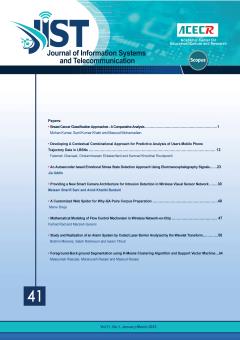Developing A Contextual Combinational Approach for Predictive Analysis of Users Mobile Phone Trajectory Data in LBSNs
محورهای موضوعی : Data MiningFatemeh Ghanaati 1 , Gholamhossein Ekbatanifard 2 , Kamrad Khoshhal Roudposhti 3
1 - Department of Computer Engineering, Rasht Branch, Islamic Azad University, Rasht, Iran
2 - Department of Computer Engineering, Lahijan branch, Islamic Azad University, Lahijan, Iran
3 - Department of Computer Engineering, Lahijan branch, Islamic Azad University, Lahijan, Iran
کلید واژه: LBSN, Trajectory data, Contextual Information, GRU,
چکیده مقاله :
Today, smartphones, due to their ubiquity, have become indispensable in human daily life. Progress in the technology of mobile phones has recently resulted in the emergence of several popular services such as location-based social networks (LBSNs) and predicting the next Point of Interest (POI), which is an important task in these services. The gathered trajectory data in LBSNs include various contextual information such as geographical and temporal contextual information (GTCI) that play a crucial role in the next POI recommendations. Various methods, including collaborating filtering (CF) and recurrent neural networks, incorporated the contextual information of the user’ trajectory data to predict the next POIs. CF methods do not consider the effect of sequential data on modeling, while the next POI prediction problem is inherently a time sequence problem. Although recurrent models have been proposed for sequential data modeling, they have limitations such as similarly considering the effect of contextual information. Nonetheless, they have a separate impact as well. In the current study, a geographical temporal contextual information-extended attention gated recurrent unit (GTCI-EAGRU) architecture was proposed to separately consider the influence of geographical and temporal contextual information on the next POI recommendations. In this research, the GRU model was developed using three separate attention gates to consider the contextual information of the user trajectory data in the recurrent layer GTCI-EAGRU architecture, including timestamp, geographical, and temporal contextual attention gates. Inspired by the assumption of the matrix factorization method in CF approaches, a ranked list of POI recommendations was provided for each user. Moreover, a comprehensive evaluation was conducted by utilizing large-scale real-world datasets based on three LBSNs, including Gowalla, Brightkite, and Foursquare. The results revealed that the performance of GTCI-EAGRU was higher than that of competitive baseline methods in terms of Acc@10, on average, by 42.11% in three datasets.
Today, smartphones, due to their ubiquity, have become indispensable in human daily life. Progress in the technology of mobile phones has recently resulted in the emergence of several popular services such as location-based social networks (LBSNs) and predicting the next Point of Interest (POI), which is an important task in these services. The gathered trajectory data in LBSNs include various contextual information such as geographical and temporal contextual information (GTCI) that play a crucial role in the next POI recommendations. Various methods, including collaborating filtering (CF) and recurrent neural networks, incorporated the contextual information of the user’ trajectory data to predict the next POIs. CF methods do not consider the effect of sequential data on modeling, while the next POI prediction problem is inherently a time sequence problem. Although recurrent models have been proposed for sequential data modeling, they have limitations such as similarly considering the effect of contextual information. Nonetheless, they have a separate impact as well. In the current study, a geographical temporal contextual information-extended attention gated recurrent unit (GTCI-EAGRU) architecture was proposed to separately consider the influence of geographical and temporal contextual information on the next POI recommendations. In this research, the GRU model was developed using three separate attention gates to consider the contextual information of the user trajectory data in the recurrent layer GTCI-EAGRU architecture, including timestamp, geographical, and temporal contextual attention gates. Inspired by the assumption of the matrix factorization method in CF approaches, a ranked list of POI recommendations was provided for each user. Moreover, a comprehensive evaluation was conducted by utilizing large-scale real-world datasets based on three LBSNs, including Gowalla, Brightkite, and Foursquare. The results revealed that the performance of GTCI-EAGRU was higher than that of competitive baseline methods in terms of Acc@10, on average, by 42.11% in three datasets.


